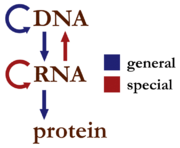Central dogma of molecular biology facts for kids
The central dogma of molecular biology is a phrase by Francis Crick, who proposed the double helix structure of DNA. It means that information passes from DNA to proteins via RNA, but proteins cannot pass the information back to DNA.
Crick first wrote it in 1958, and repeated it in 1970.
The dogma is a framework for understanding the transfer of sequence information.
There are 3 major classes of such biopolymers: DNA and RNA (both nucleic acids), and protein. There are 3×3 = 9 conceivable direct transfers of information that can occur between these. The dogma classes these into 3 groups of 3:
- 3 general transfers (believed to occur normally in most cells),
- 3 special transfers (known to occur, but only under specific conditions in case of some viruses or in a laboratory), and
- 3 unknown transfers (believed never to occur).
The general transfers describe the normal flow of biological information: DNA can be copied to DNA (DNA replication), DNA information can be copied into mRNA, (transcription), and proteins can be synthesized using the information in mRNA as a template (translation).
The dogma is a modern version of the Weismann barrier (after August Weismann). This is the principle that hereditary information moves only from genes to body cells, and never in reverse. Hereditary information moves only from germline cells to somatic cells.
Images for kids
See also
 In Spanish: Dogma central de la biología molecular para niños
In Spanish: Dogma central de la biología molecular para niños



